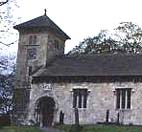![]() Domesday
Book
Domesday
Book
![Extract from the Domesday Book. [Public Record Office]](images/db.jpg) In
1085 England was threatened by King Cnut II of Denmark which prompted William
the Conqueror to order a survey of the resources of the kingdom which could be
taxed to fund his forces. This survey led to the compilation of the Domesday
Book which people compared to the Last Judgement, the day of doom, in the
Bible.
In
1085 England was threatened by King Cnut II of Denmark which prompted William
the Conqueror to order a survey of the resources of the kingdom which could be
taxed to fund his forces. This survey led to the compilation of the Domesday
Book which people compared to the Last Judgement, the day of doom, in the
Bible.
 The basic unit of landholding
referred to in the Domesday Book is the manor.
This could be a great estate, a village or a few farms. Domesday Book lists
the holder and value of each manor in King Edward the Confessor’s day and at
the time of the survey as well as its tax liability, resources such as ploughs
and woodland, and, sometimes, livestock. The landholdings of each county are
listed beginning with those of the king and then those of the chief landowners
in such a way as to give a picture of the social structure of Norman England.
The basic unit of landholding
referred to in the Domesday Book is the manor.
This could be a great estate, a village or a few farms. Domesday Book lists
the holder and value of each manor in King Edward the Confessor’s day and at
the time of the survey as well as its tax liability, resources such as ploughs
and woodland, and, sometimes, livestock. The landholdings of each county are
listed beginning with those of the king and then those of the chief landowners
in such a way as to give a picture of the social structure of Norman England.
![]()
 Although some written estate records
were used, Domesday Book was largely compiled by using statements from local
people sworn under oath in the courts of the shires and lesser local
government units, the hundreds and wapentakes. For administrative convenience
England (except Cumberland, Durham and Northumberland) was divided into seven
or eight assessment ‘circuits’ which were visited by teams of
commissioners, barons from a different part of the country to that being
assessed. The information was written up in standardised form at Winchester
and stored in the Treasury.
Although some written estate records
were used, Domesday Book was largely compiled by using statements from local
people sworn under oath in the courts of the shires and lesser local
government units, the hundreds and wapentakes. For administrative convenience
England (except Cumberland, Durham and Northumberland) was divided into seven
or eight assessment ‘circuits’ which were visited by teams of
commissioners, barons from a different part of the country to that being
assessed. The information was written up in standardised form at Winchester
and stored in the Treasury.